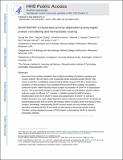| dc.contributor.author | Shin, Seung Min | |
| dc.contributor.author | Zhang, Nanyan | |
| dc.contributor.author | Hansen, Jonathan | |
| dc.contributor.author | Gerges, Nashaat Z | |
| dc.contributor.author | Pak, Daniel TS | |
| dc.contributor.author | Sheng, Morgan | |
| dc.contributor.author | Lee, Sang H | |
| dc.date.accessioned | 2023-03-30T18:41:07Z | |
| dc.date.available | 2023-03-30T18:41:07Z | |
| dc.date.issued | 2012 | |
| dc.identifier.uri | https://hdl.handle.net/1721.1/150027 | |
| dc.description.abstract | How does chronic activity modulation lead to global remodeling of proteins at synapses and synaptic scaling? Here we report that guanylate kinase-associated protein (GKAP; also known as SAPAP), a scaffolding molecule linking NMDA receptor-PSD-95 to Shank-Homer complexes, acts in these processes. Overexcitation removes GKAP from synapses via the ubiquitin-proteasome system, whereas inactivity induces synaptic accumulation of GKAP in rat hippocampal neurons. Bidirectional changes in synaptic GKAP amounts are controlled by specific CaMKII isoforms coupled to different Ca 2+ channels. CaMKIIα activated by the NMDA receptor phosphorylates GKAP Ser54 to induce polyubiquitination of GKAP. In contrast, CaMKIIβ activation via L-type voltage-dependent calcium channels promotes GKAP recruitment by phosphorylating GKAP Ser340 and Ser384, which uncouples GKAP from myosin Va motor complex. Overexpressing GKAP turnover mutants not only hampers activity-dependent remodeling of PSD-95 and Shank but also blocks bidirectional synaptic scaling. Therefore, activity-dependent turnover of PSD proteins orchestrated by GKAP is critical for homeostatic plasticity. © 2012 Nature America, Inc. All rights reserved. | en_US |
| dc.language.iso | en | |
| dc.publisher | Springer Science and Business Media LLC | en_US |
| dc.relation.isversionof | 10.1038/nn.3259 | en_US |
| dc.rights | Creative Commons Attribution-Noncommercial-Share Alike | en_US |
| dc.rights.uri | http://creativecommons.org/licenses/by-nc-sa/4.0/ | en_US |
| dc.source | PMC | en_US |
| dc.title | GKAP orchestrates activity-dependent postsynaptic protein remodeling and homeostatic scaling | en_US |
| dc.type | Article | en_US |
| dc.identifier.citation | Shin, S. M., et al. "Gkap Orchestrates Activity-Dependent Postsynaptic Protein Remodeling and Homeostatic Scaling." Nature Neuroscience (2012). | en_US |
| dc.contributor.department | Massachusetts Institute of Technology. Department of Brain and Cognitive Sciences | en_US |
| dc.relation.journal | Nature Neuroscience | en_US |
| dc.eprint.version | Author's final manuscript | en_US |
| dc.type.uri | http://purl.org/eprint/type/JournalArticle | en_US |
| eprint.status | http://purl.org/eprint/status/PeerReviewed | en_US |
| dc.date.updated | 2023-03-30T18:34:33Z | |
| dspace.orderedauthors | Shin, SM; Zhang, N; Hansen, J; Gerges, NZ; Pak, DTS; Sheng, M; Lee, SH | en_US |
| dspace.date.submission | 2023-03-30T18:34:36Z | |
| mit.journal.volume | 15 | en_US |
| mit.journal.issue | 12 | en_US |
| mit.license | OPEN_ACCESS_POLICY | |
| mit.metadata.status | Authority Work and Publication Information Needed | en_US |
